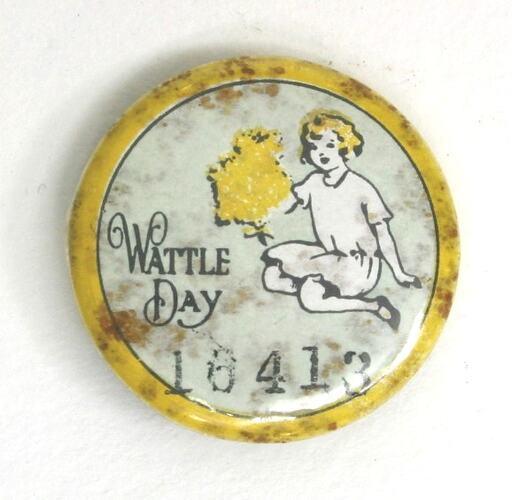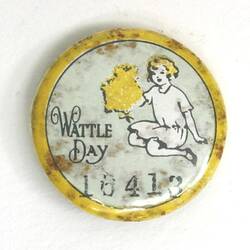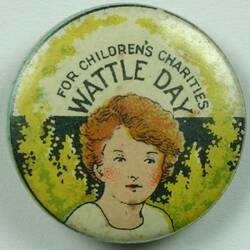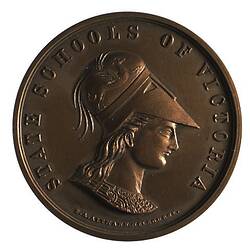Summary
Alternative Name(s): Button
Yellow and blue (faded) 'Wattle Day' badge featuring a seated girl holding a bouquet of wattle. Manufactured by A.W. Patrick, North Fitzroy, Melbourne, circa 1914 and 1919.
One of 13 fundraising badges originally attached to a blue velvet ribbon. The badges all date from the World War I era, 1914-1919. They were purchased or collected by the donor's great-grandmother, Mrs Lillie Mary Holinger. The Hollinger family lived at Panton Hill when World War I broke out. They moved to Canterbury, Melbourne, in 1918, and in the 1930s moved to Ferny Creek. Mrs Holinger's daughter, also Lillie Mary, born in 1896, married returned serviceman David James Gillespie in 1922.
Badges were displayed on ribbons during and after World War I, commemorating involvement in the war effort. Rosalie Triolo notes that children particularly enjoyed displaying badges that they had bought as fund-raisers for the war. One former child, Winifred Grassick, remembered that Red Cross buttons were posted to schools each month by the Education Department. to be sold for a shilling each. 'They surely must have raised a significant sum because they were a regular feature of even our small school. We took an interest and pride in being able to display a ribbon containing the whole sequence', she remembered. (Rosalie Triolo, 2012, 'Our Schools and the War', p.81).
The badges have been removed from their original ribbon by Museum Victoria staff for conservation reasons.
The first 'national' Wattle Day was celebrated in Sydney, Melbourne and Adelaide on 1 September 1910. Wattle had become a symbol of Australia with the approach of Federation. It was particularly promoted by the Australian Natives' Association, established in Melbourne in 1871 as a non-partisan and non-sectarian friendly society for Australian-born, white men seeking to shape Australia's nationhood and identity. The ANA was a strong advocate for Federation and became an advocate for White Australia. It was a staunch supporter of trade protection and immigration restriction, and Prime Minister Alfred Deakin was a member. Public support for Wattle Day peaked during World War I, when it was a potent symbol of home for military personnel serving overseas, and a means of raising money for organisations such as the Red Cross. Beautifully designed Wattle Day badges as well as wattle sprigs were sold. The influence of Wattle Day waned as the 20th century progressed, but in 1992 the Governor-General declared 1 September National Wattle Day.
Physical Description
This circular badge, pictures a young girl (dressed in white with blond hair) kneeling, holding a large (yellow) wattle sprig in her hand. There is black text on the left hand side of the badge. The design is on a pale blue background and is encircled by a yellow boarder. A number has been stamped near the bottom edge.
More Information
-
Collection Names
-
Collecting Areas
-
Acquisition Information
Donation from Mrs Bronwyn Mitchell, 15 Feb 1994
-
Manufacturer
A.W. Patrick, North Fitzroy, Greater Melbourne, Victoria, Australia, 1914-1919
-
Organiser of Event
Australian Native Association, Australia, post 1871
Wattle Day was an initiative of the Australian Natives Association (ANA) and the Wattle Blossom League. -
Organiser of Event
Wattle Blossom League, Australia, post 1889
Wattle Day was an initiative of the Australian Natives Association (ANA) and the Wattle Blossom League. -
Place & Date Used
-
Inscriptions
In black text: WATTLE / DAY; 16413
-
Classification
-
Category
-
Discipline
-
Type of item
-
Overall Dimensions
2.3 cm (Width)
-
Keywords
Fundraising, Wars & Conflicts, Wattle Day, World War I, 1914-1918




